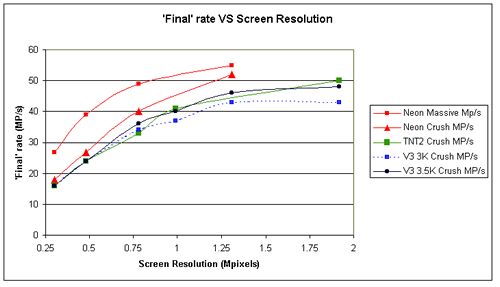Today everybody is looking at higher and higher frame-rates at higher and higher resolutions. And everybody is talking about fill-rate and more fill-rate because, as most people know, the more fill-rate the higher the possible frame-rate. There is, however, a second factor playing a very important role, and many people are losing track of this factor. This of course is the CPU. Have you noticed how "every" company is running benchmarks on a P3-500Mhz these days?
Simon Fenney, one of the design engineers from Videologic, had some free
time on his hands (probably finished the algorithms for the PowerVR Series
4 already by now) and he came up with this nice little forum post:
Out of curiosity, I tried to see what might be the limiting factor in these scores, so I decided to plot screen resolution (measured in Mega Pixels) vs the "Final" fill rate (i.e. Screen res * frame rate). This should give some idea of what might be limiting the rate of each of the cards. Since the tests should be the same, the overdraw etc shouldn't really matter.
Anyway, after a large struggle with Excel, I got the following results :
It appears to me that the
CPU is still _the_ major factor in all the benchmarks, at least at the
low resolution end.
At the upper end, the V3 3K seems to have hit the wall at about the 1.25Mp screen res' mark, while the 3.5k seems to stop a little after that.
The TNT2 (I think this is a 150Mhz clocked one) still appears to have some headroom, but it could just be that, because there is no sample point at around 1.25, we are getting misleading results. Still, it looks quite promising.
I would guess that the Neon will bottle out at about around (sub) 60, assuming that the quake polys are all dual textured (and the clock rate is 125Mhz). (I could have done with some higher res benchmark figures here, but the curve does seem relatively well behaved). I would hazard a guess that there may just be some opaque overdraw going on in these games.
What does confuse me, however, is the funny wavers in the the TNT2 and V3 curves between .75 and 1 Mpixels. The only thing I could think of was it was some sort of VSync issue, but surely these are turned off for benchmarking?
Anyway, it seems that the CPU manufactures are lagging behind their graphics chip counterparts.
Any comments?
Simon Fenney
Looking at these graphics it seems like VideoLogic's Neon 250 has pretty good CPU dependency, this means that it should run pretty good even on lower end CPUs. Feel free to leave comments in our brand new forum that can be found here... or drop us an email.For those that haven't seen the Neon 250 results :
| Benchmark (Res) | Score Achieved | TNT2 Score | Voodoo3 3000 Score |
| Q2 Massive1 (640) | 87.9fps | N/A | N/A |
| Q2 Massive1 (800) | 81.3fps | N/A | N/A |
| Q2 Massive1 (1024) | 62.5fps | N/A | N/A |
| Q2 Massive1 (1280) | 42.5fps | N/A | N/A |
| Q2 Crusher (640) | 58.6fps | 52.6fps | 52.1fps |
| Q2 Crusher (800) | 57.3fps> | 50.4fps | 51.9fps |
| Q2 Crusher (1024) | 52fps | 43.1fps | 43.4fps |
| Q2 Crusher (1280) | 40fps | 41.4@1152 | 33fps |
| 3DMark 99 Max | 4209 | 3500 | 3268 |
| Quake 2 scores from Tom's
Hardware, 3D Mark Max scores from 3DMark
Neon 250 and TNT2 scores for 24/32 bits color, 16 bit for V3. |
|||

